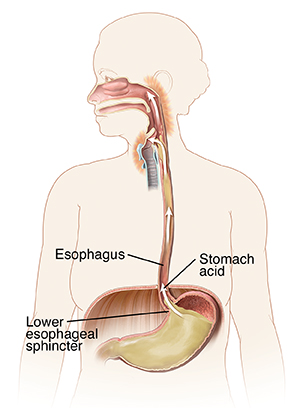If you often have a painful, burning feeling in your chest after you eat, you may have gastroesophageal reflux disease (GERD). Heartburn that keeps coming back is a classic symptom of GERD. But you may have other symptoms as well. A GERD diagnosis is made only after a complete evaluation by your healthcare provider.
When you have a reflux problem
After you eat, food travels from your mouth down the esophagus to your stomach. Along the way, food passes through a one-way valve called the lower esophageal sphincter (LES). The LES sits at the opening to your stomach. Normally the LES opens when you swallow. It lets food enter the stomach, then closes quickly. With GERD, the LES doesn’t work normally. It lets food and stomach acid flow back (reflux) into the esophagus. This creates the burning sensation.
 |
| With GERD, the weak LES allows food and fluids to travel back, or reflux, into the esophagus. |
Relieving your discomfort
You and your healthcare provider can work together to find the treatment choices to best ease your symptoms. These may include lifestyle changes, medicine, or possibly surgery.
Many people find their GERD symptoms decrease when they eat small frequent meals instead of three large ones. Reducing the amount of fatty, spicy, and acidic foods in your diet will also help.
The following foods tend to cause problems for people diagnosed with GERD:
To ease your symptoms, raise the head of your bed 4 to 6 inches. Don't eat anything within 2 to 3 hours of laying down.
Losing weight, if you are overweight, often eases GERD symptoms.
Stopping smoking can also help GERD symptoms.
Talk with your healthcare provider if you don’t understand how to make the dietary changes needed to control your GERD symptoms. Your provider can refer you to a nutritionist or recommend certain medicines to reduce the acid buildup.